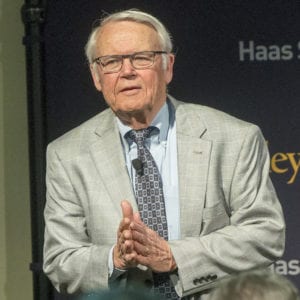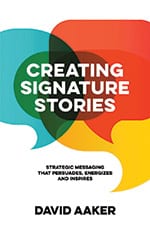Why storytelling is essential for brand marketing

Back in 1984, Zhang Ruimin was promoted to lead a struggling Chinese refrigerator company that would later become Haier. When a customer brought in a defective fridge, he went through an inventory of 400 units to find a replacement; unfortunately, he found that 20 percent of them were also faulty. Ruimin promptly ordered all of the defective units to be brought to the factory floor and gave the employees sledgehammers, inviting them to destroy them.
“That dramatic story led to a change in the firm’s quality culture that is a foundation of Haier today,” says David Aaker, professor emeritus of marketing strategy and vice chairman of the brand consultancy Prophet. “Asserting that the firm was going to have a quality-first culture would not be noticed or believed. But the story penetrates.”
Aaker, who has been called the “father of modern branding,” uses that example in his new book, Creating Signature Stories: Strategic Messaging that Energizes, Persuades and Inspires (Morgan James Publishing, 2018), to show how effective stories can be in creating an organizational culture or managing a brand’s image. “It is so difficult today to cut through the clutter and engage a disinterested and skeptical audience,” Aaker says. “Stories are enormously powerful, and can be much more impactful than facts.”
Stories work, studies have found, because they engage the emotions, allow listeners to deduce the logic for themselves, and are much more difficult to argue against than facts.
For businesses, stories can be helpful in engaging both employees and customers. “There is a whole cadre of young employees who will not work for companies they are not proud of,” says Aaker. “If you want to compete for the best people, you need to have a higher purpose, and the way to communicate that is with a story.” At the same time, a small but meaningful subset of customers is looking for authentic engagement with a brand.
“If you want to compete for the best people, you need to have a higher purpose, and the way to communicate that is with a story.”
— Prof. Emeritus David Aaker

For companies looking to find or create a “signature story,” Aaker first recommends they hone the strategic message they are trying to communicate. Then, he suggests that they focus on a protagonist who can exemplify that message—whether it’s a customer, an employee, a leader, or a product. L.L.Bean company founder Leon L. Bean, for example, had a stitching problem with the first 100 boots he sold that made them less than watertight. He refunded every customer’s money, though it nearly put him out of business.
While there is “no checklist of elements a signature story has to have,” Aaker says it helps if it is intriguing, authentic, and engaging. Generating and testing such stories can take serious investment by companies, some of which have hired editors, videographers, social media experts, and even chief story officers to make up a storytelling team. After creating a signature story, it can become an art in itself to disseminate it and keep it alive over time. To this day, Haier has a sledgehammer on display at its corporate offices in China.
By learning how to tell authentic and emotionally engaging signature stories, companies can assure that their employees and companies associate them with a higher purpose, creating loyalty to the brand for years to come.